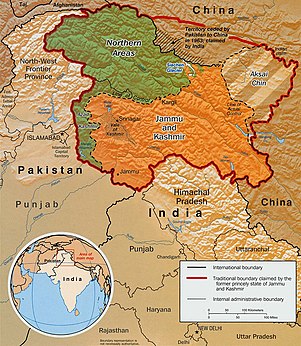Sia La
35°34′55″N 76°47′33″E / 35.58194°N 76.79250°E / 35.58194; 76.79250



Sia La is a mountain pass situated on Saltoro Ridge, in Ladakh, India, some 60 km (37 mi) north-northwest of map point NJ9842 which defined the end of the 1972 Line of Control between India and Pakistan as part of the Simla Agreement.[1] Sia La sits near the Chinese border and immediately northwest of the upper part of the vast Siachen Glacier, connecting that glacier to the Pakistani-controlled Kondus Glacier and valley to the west.
Geopolitical issues
Sia La, as well as nearby passes Bilafond La and Gyong La, saw military action starting in 1984 during Operation Meghdoot, the first military action of the Siachen conflict, itself being part of larger conflict, the Kashmir conflict.[2] All three passes are currently held by India; However, Pakistan controls a pass just to the west that overlooks Sia La. They call it Conway Saddle & Leghari OP.
See also
- Near the AGPL (Actual Ground Position Line)
- NJ9842 LoC ends and AGPL begins
- Gyong La
- Chumik Glacier
- Saltoro Mountains
- Saltoro Kangri
- Ghent Kangri
- Bilafond La
- Indira Col, AGPL ends at LAC
- Borders
- Actual Ground Position Line (AGPL)
- India–Pakistan International Border {IB)
- Line of Control {LoC)
- Line of Actual Control (LAC)
- Sir Creek (SC)
- Borders of China
- Borders of India
- Borders of Pakistan
- Conflicts
- Kashmir conflict
- Siachen conflict
- Sino-Indian conflict
- List of disputed territories of China
- List of disputed territories of India
- List of disputed territories of Pakistan
- Northern Areas
- Trans-Karakoram Tract
- Operations
- Operation Meghdoot, by India
- Operation Rajiv, by India
- Operation Safed Sagar, by India
- Other related topics
- Awards and decorations of the Indian Armed Forces
- Bana Singh, after whom Quaid Post was renamed to Bana Top
- Dafdar, westernmost town in Trans-Karakoram Tract
- India-China Border Roads
- List of extreme points of India
- Sino-Pakistan Agreement for transfer of Trans-Karakoram Tract to China
References
Citations
- Close C, Burrard S, Younghusband F, et al. (1930). "Nomenclature in the Karakoram: Discussion". The Geographical Journal. 76 (2). Blackwell Publishing: 148–158. doi:10.2307/1783980. JSTOR 1783980.
- "A Slow Thaw". Time. 7 November 2005. Archived from the original on 11 September 2005. Retrieved 23 May 2010.
External links
- Siachen Peace Park
- v
- t
- e
| Mountain railways | |
|---|---|
| Rail mountain passes |
|
| Ladakh | |
|---|---|
| Himalaya |
|
| Western Ghats |
|
| Vindhya |
|
| Others |
|
 | This Ladakh, India location article is a stub. You can help Wikipedia by expanding it. |
- v
- t
- e












